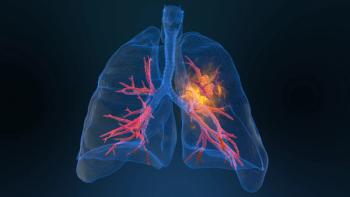
Study Details Characteristics of Patients with COPD, Asthma
Danish investigators reviewed data of individuals prescribed inhaled corticosteroids (ICS) for chronic obstructive pulmonary disease (COPD) to compare characteristics of patients who have COPD alone with those who have COPD and concomitant asthma.
Danish investigators reviewed data of individuals prescribed inhaled corticosteroids (ICS) for chronic obstructive pulmonary disease (
Patients with COPD and asthma are more likely to be younger, have more preserved lung function, and be diagnosed with depression compared with those who have COPD alone, according to the
Using data provided by general practicioners, researchers assessed patient demographics, smoking habits, spirometry, COPD medication, dyspnea score, and exacerbation histories. Patients included in the study had confirmed diagnoses of COPD, were currently prescribed ICS, and were managed by general practitioners, most often in primary care.
Records showed 2289 patients with COPD currently on ICS therapy who were eligible for analysis, of which 540 had concomitant asthma. The total cohort skewed slightly female (55%) and had a mean age of 71.
Compared with those with COPD alone, patients with COPD plus asthma were slightly younger with an average age of 69 compared with 72. Patients with COPD and asthma also had fewer
While patients with COPD and patients with COPD and asthma exhibit many of the same comorbidities, in the COPD-only cohort, researchers found cardiovascular disease, type 2 diabetes and osteoporosis to be more prevalent than in individuals with COPD and asthma. In contrast, patients with COPD plus asthma exhibited higher rates of depression and anxiety.
“Reduced benefit from corticosteroids and increased inflammation in the airways has previously been suggested as a side effect of being a current smoker in patients with chronic airway diseases such as COPD and asthma,” researchers said.
However, data from 3 randomized trials found currently smoking patients with COPD on ICS/ long-acting beta agonist (LABA) therapy exhibited reduced rates of exacerbations compared with those on LABA-only regimens at greater blood-eosinophil counts.
In line with these findings, the current study found patients with COPD “with concomitant asthma and on average higher mean blood eosinophil count had a lower exacerbation rate compared to patients with COPD alone and a lower blood eosinophil count.” This finding indicates ICS is more beneficial in the group of patients with COPD and concomitant asthma, authors said.
Overall, diagnoses of concomitant asthma among patients with COPD were associated with higher rates of depression, less exposure to tobacco smoke, and greater lung function, authors concluded.
“These main differences between patients with COPD alone and COPD with concomitant asthma indicate the need for investigation of detailed treatment strategies in primary care COPD patients, not least for those with concomitant asthma, and hopefully, reduce risk of unbeneficial ICS treatment in the future."
Reference:
Savran O, Godtfredsen NS, Sørensen T, et al. Comparison of characteristics between ICS-treated COPD patients and ICS-treated COPD patients with concomitant asthma: a study in primary care. Int J Chron Obstruct Pulmon Dis. 2020;2020(15):931-937. doi: 10.2147/COPD.S241561
Newsletter
Stay ahead of policy, cost, and value—subscribe to AJMC for expert insights at the intersection of clinical care and health economics.















































